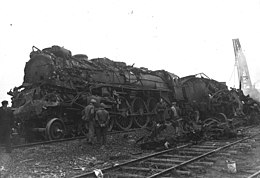Lagny railway accident
The Lagny railway accident occurred on December 23, 1933, when an express train from Paris to Strasbourg caught another express train from Paris to Nancy . With 204 deaths, this was one of the worst railway accidents in peacetime.
Starting position
The Paris – Strasbourg line was operated by the Compagnie des chemins de fer de l'Est , and there was very thick fog on the section of the route that evening.
The reinforcement train No. 55 of the pre-Christmas traffic from Paris to Nancy left Paris Gare de l'Est at 19:31 with a delay of almost 1½ hours. He ran older cars , the car bodies of which were mostly made of wood , and which were only used because there was a particularly high demand for vehicles due to the holiday traffic . Between Pomponne and Lagny-sur-Marne , the train had to stop in front of a signal showing "stop". Because of the poor visibility, train attendants also secured the train to the rear with blasting capsules .
The first train was followed by another, which was en route from Paris to Strasbourg. This left the Paris Ostbahnhof just two minutes after the first train. Both trains were very busy with passengers due to the Christmas traffic.
the accident
The staff on the locomotive of the second train recognized the signal covering the train in front as showing "clear travel". The crackers didn't hear it. When the express train from Paris to Nancy began to accelerate again, it was rammed from behind by the second express train from Paris to Strasbourg at the maximum speed of around 110 km / h.
consequences
During the impact, the locomotive of the rear train plowed through the last five passenger cars on the train to Nancy, the wooden car bodies of which were completely smashed. 204 people died in the accident and 120 were injured, the vast majority in the last five cars on the train to Nancy.
The dead were laid out in the baggage handling facility at Paris' Ostbahnhof, which had been converted into a mourning hall , where the then French President Albert Lebrun said goodbye to the dead.
The commission of inquiry that was set up did not come to a clear conclusion. The driver of the train to Strasbourg was acquitted in the criminal proceedings against him on January 25, 1935 because of doubts about the proper functioning of the signals in dubio pro reo .
Consequences
As a consequence of the accident, a number of modernizations and changes were pursued:
- The decommissioning of passenger cars with a wooden structure from the 19th century was forced, as cars made of steel are much more stable. However, as a result of the Second World War , it was not until 1962, then by the SNCF , that the last ones could be retired.
- The lighting of the signals was switched from petroleum lamps to light bulbs, which were much brighter and therefore more visible.
- The signaling on the main lines has been fundamentally changed. To do this, the distant signal, which until then consisted of two poorly visible green lamps, was replaced by a yellow lamp.
- The stop signal, which until then consisted of a green and a red light, was switched to a red light.
- The signal “Drive free”, until then a white light, was switched to a green light to reduce the risk of confusion.
- The combination of lights for signals that were both main and distant signals and showed up to four lights has been simplified to provide a better overview.
swell
- Documentation by the Granada Bristol for the National Geographic Channel on railway safety.
- Ascanio Schneider u. Armin Masé: Disasters on the rails. Railway accidents, their causes and consequences . Zurich 1968, pp. 66–69.
Remarks
- ^ Schneider / Masé, p. 68, and Peter WB Semmens: Catastrophes on rails. A worldwide documentation. Transpress, Stuttgart 1996, ISBN 3-344-71030-3 , p. 87, name 230 dead and 500/300 injured.
Individual evidence
- ^ Schneider / Masé, p. 66.
- ↑ Schneider / Masé, p. 68.
- ↑ Center Historique des Archives Nationales: Cérémonies publiques, funérailles nationales et obsèques aux frais de l'État (1899–1943) (PDF, 1.1 MB) The number of dead and injured on p. 15 (French).
- ↑ Journal Le Figaro v. January 25, 1935, p. 4.
Coordinates: 48 ° 52 '53.1 " N , 2 ° 41' 37.9" E
